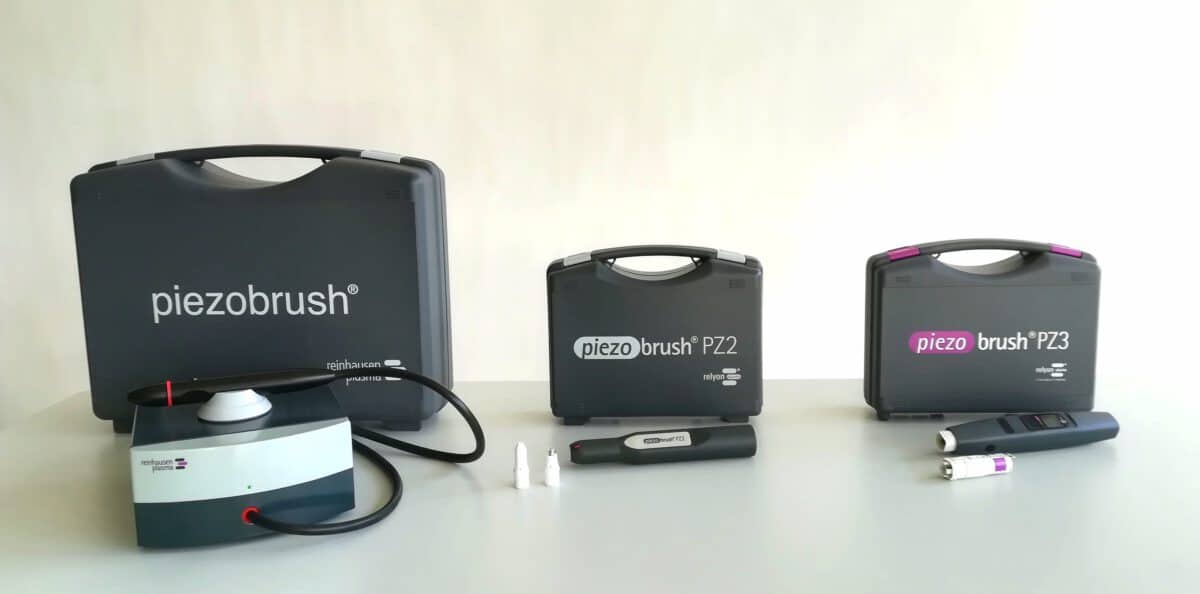Piezoelectric Direct Discharge – Devices and Applications
Authors: Dariusz Korzec, Florian Hoppenthaler and Stefan Nettesheim
Date: December 2020
Abstract
The piezoelectric direct discharge (PDD) is a comparatively new type of atmospheric pressure gaseous discharge for production of cold plasma. The generation of such discharge is possible using the piezoelectric cold plasma generator (PCPG) which comprises the resonant piezoelectric transformer (RPT) with voltage transformation ratio of more than 1000, allowing for reaching the output voltage >10 kV at low input voltage, typically below 25 V. As ionization gas for the PDD, either air or various gas mixtures are used. Despite some similarities with corona discharge and dielectric barrier discharge, the ignition of micro-discharges directly at the ceramic surface makes PDD unique in its physics and application potential. The PDD is used directly, in open discharge structures, mainly for treatment of electrically nonconducting surfaces. It is also applied as a plasma bridge to bias different excitation electrodes, applicable for a broad range of substrate materials. In this review, the most important architectures of the PDD based discharges are presented. The operation principle, the main operational characteristics and the example applications, exploiting the specific properties of the discharge configurations, are discussed. Due to the moderate power achievable by PCPG, of typically less than 10 W, the focus of this review is on applications involving thermally sensitive materials, including food, organic tissues, and liquids.
Introduction
The low temperature or cold atmospheric pressure plasmas (APP) are versatile tools in a large number of human activities. Their applications are ranging from improvement of industrial production processes, to numerous applications in biology, genetics, and medicine. The increasing demand on a compact, affordable, and flexible plasma tools motivated the development of a new family of piezoelectric cold plasma generators (PCPG) based on the resonant piezoelectric transformer (RPT) principle. The use of PCPG to produce the piezoelectric direct discharge (PDD) is the focus point of this review. The operation power range of 3 to 10 W makes PCPGs especially suitable for implementation in compact desktop instruments or in handheld atmospheric pressure plasma jets (APPJ). The low temperature of the produced plasma gases, only a few K higher than the ambient temperature, makes the treatment of fruits, seeds, and tissues feasible. The high achievable ozone concentration allows for application for disinfection and sterilization. These are only a few of the strongly diverging application field examples. In this review, different configurations of PCPG driven devices are classified, and their operation principles are explained. The suitability of these configurations for specific classes of applications is discussed and illustrated with practical application examples. The authors hope that this review will inspire completely new fascinating approaches and application fields, not yet revealed.

Conclusion and Outlook
This review shows the use of three types of PCPG for generation of the PDD. Based on the PCPG, several handheld, versatile plasma tools were developed, allowing the treatment of wide range of thermally sensitive substrates such as implants, fruits, or liquids. This versatility is achieved by using different excitation structures, such as DBD, APPJ, FE-DBD, SMD, or plasma needle, all powered by the same PCPG. PCPG is able to produce a high ozone concentration in air or in oxygen. The ozone concentrations of 250 in air and 800 ppm in oxygen, and the production rates of 80 mg/h and 250 mg/h, respectively, are achieved. For evaluation of the activation performance of the different discharge configurations, the activation area on LDPE substrates visualized by use of 58 mN/m test inks is used. For both: open nozzle and DBD nozzle operation the activation results correlate with the number of micro-discharges per PCPG oscillation cycle. The correlation between the specific discharge architecture and its optimal processing targets is discussed. Specifically, three configurations of PCPG driven DBD discharges are evaluated on the basis of activation area. The best results were achieved with single DBD with the excitation electrode driven over the plasma bridge. The second best is the configuration with the double DBD driven directly by the PCPG. The weakest results were achieved with double DBD with the excitation electrode driven over the plasma bridge. The needle electrode powered by PCPG over the plasma bridge is able to produce plasma in different gases, reaching the activation results comparable with the open PDD. The generation of piezoelectric direct discharge is a considerably new discipline in the atmospheric pressure plasma world. Consequently, many interesting questions are still not answered. Some examples of scientifically challenging subjects are:
- Physics of the PDD plasma bridge, especially its temporal development, and electric parameter determining its power coupling capacity.
- Influence of humidity on the PDD properties, chemistry, and microbiocidal activity.
- Control of the PDD chemistry by shaping the excitation signal, for example by pulse width modulation.




